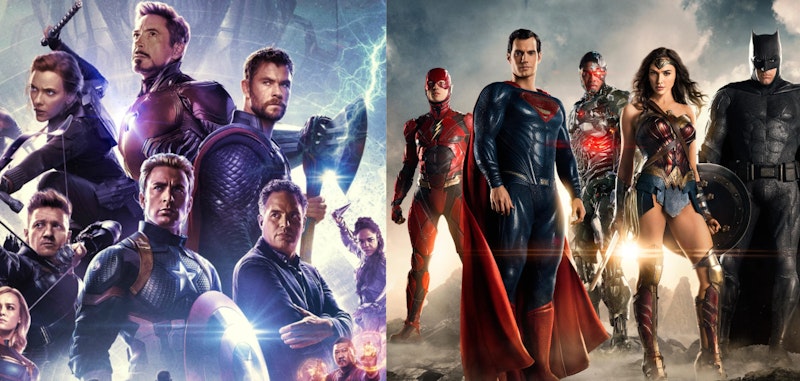I’m hopeful that we’re nearing the end of the Hollywood strikes and will soon see resumed production for some movies slated to be released in 2024. Then again the creative process, if you can call it that, for big movie franchises such as Marvel and DC superheroes has become so bureaucratic that it’s amazing any of these projects reach completion—even when they aren’t stymied by a flurry of new, often petty union rules.
Marvel and DC, well before the recent writer and actor strikes, painted themselves into oddly similar corners despite Marvel movies' general box office successes and DC movies' box office failures. Despite the fact that Marvel's print comics mainly have had one coherent fictional universe and DC has a shifting multiverse with many versions of their main characters (a World War II-era Batman, etc.), both companies have somehow ended up gridlocked on the big screen with a flurry of third-tier characters and cheap-looking CGI effects.
This happened because Marvel briefly believed, inspired by the success of vast ensemble films like Avengers: Infinity War and Avengers: Endgame, that they could do no wrong. Thus they put many nitpicky little projects into the production pipeline that they have stuck with through the end of this decade, climaxing with the multiversal apocalypse called Avengers: Secret Wars. Comparatively DC has become increasingly aware that they can do almost nothing right and chose instead to put many nitpicky little projects into the pipeline as experiments, hoping in vain something would prove incredibly popular even if no larger tapestry was woven.
Joaquin Phoenix’s Joker and Robert Pattinson’s Batman were hits but don’t live in the same DC world as Jason Momoa’s fluke megahit Aquaman. The new DC president/mouthpiece James Gunn, no matter how much he talks up his plans for a coherent series of Superman-and-his-universe films, is powerless before DC/Warner’s deep financial woes to make all of this fit together smoothly.
The sanest escape route for DC would simply be to declare their popular properties as elements of a larger multiverse and let them continue as-is. Unfortunately Gunn’s mission statement to the panicked new owners of Warner was essentially that they would mimic the one-coherent-world Marvel model, a model to which Marvel itself no longer seems that wedded, so he careens between promoting and then disowning whole characters and worlds. As he must, these characters and storylines bubble up for movie-promotion purposes and then fade away with poor box office returns.
All next year, Gunn will talk about Lady Gaga being the perfect definitive version of villain Harley Quinn, since the Joker sequel in which she appears as Harley is DC’s only planned film for 2024. If that film doesn’t make as much money as its billion-dollar predecessor, he’ll lurch back to claiming his pal Margot Robbie, now seen as box office gold because of the success of Barbie, is the Harley Quinn you’ve always known and loved. She will be lauded as perfect for appearing alongside whatever new Batman is rolled out by Gunn, even if that Batman is supposed to be representative of a whole new universe unconnected to the previous three films.
This process doesn’t have to be jarring but it likely will be, in part because creative types like Gunn and now-ousted print editor Dan DiDio have little choice but to roll with the punches as contradictory corporate-bureaucratic edicts descend upon them. Make it one universe! Bring back Joaquin! Say it’s all part of one universe called the DCU! Make Marvel-sized money! Experiment with obscure characters! Ditch the multiverse! But use three Batmen! And three Jokers!
In a partial reversal of the print traditions, the on-screen Marvel characters flit between different Earths and leave many fans longing for a stable Iron Man or Reed Richards to hold onto. While DC keeps insisting it will soon weave all its films into a single consistent world, a glance at their schedule shows that DC’s last seven money-losing films will be followed by four films each set in a completely different fictional continuity. Of course with nary a mention of a larger multiverse to place them all in a larger whole (aside from the glimpses of a multiverse in the recent failed Flash film and now-canceled CW network superhero shows).
As I know from a bit of professional dabbling in comics two decades ago, and as attentive fans know from watching well-meaning carny barkers like DC’s DiDio spout vague contradictory announcements about future stories, the harried people who control the superheroes we love spend very little time asking themselves fanboy questions such as “What year did Krypton explode?” and nearly every minute of their lives asking themselves desperate questions along the lines of “How the hell are we supposed to get this to the printer before the second edition, which contradicts it, goes out if no one at the other office will sign off on it?”
Now multiply that by a few megacorporate mergers, several angry unions, and uncaring fickle audiences—not to mention contract disputes over toy tie-ins and soundtrack release schedules—and you have some idea what your favorite heroes are really up against, trivialities like invading Skrulls or colliding Earths notwithstanding.
—Todd Seavey is the author of Libertarianism for Beginners and is on X at @ToddSeavey

